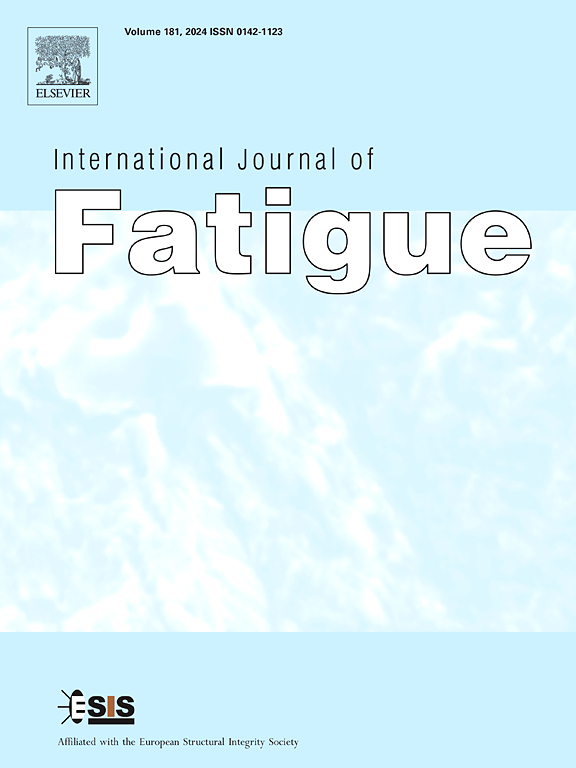超高性能混凝土-正常强度混凝土界面约束应变疲劳裂纹扩展研究
IF 6.8
2区 材料科学
Q1 ENGINEERING, MECHANICAL
引用次数: 0
摘要
超高性能混凝土(UHPC)作为一种先进的建筑材料,在老化混凝土基础设施的修复中得到了突出的应用。当UHPC与标准强度混凝土(NC)结合时,两种混凝土之间的界面成为潜在的薄弱环节,特别是在疲劳荷载作用下。由于UHPC和NC之间收缩行为的显著不匹配,从而导致界面处的应力集中,抑制收缩进一步加剧了这种脆弱性。研究了约束应变条件下uhpc - NC界面疲劳裂纹扩展特性。该研究的新颖之处在于它关注了UHPC-NC界面的约束应变与疲劳裂纹扩展之间的关系,这是以往研究中很大程度上未探索的领域。试验程序包括自由收缩和约束收缩试验,以及约束应变条件下的I型和I- ii型混合疲劳试验。研究了减缩添加剂的添加、固化条件和模态类型等变量。研究了UHPC-NC界面的约束应变,分析了UHPC-NC界面的疲劳行为,包括疲劳寿命、失效模式、柔度行为、疲劳应变分析和疲劳损伤演化。利用Spearman相关系数探讨了UHPC-NC界面约束应变与最大裂纹张开位移(CMOD)之间的关系。结果表明,添加减缩剂可有效降低UHPC的自由收缩,从而降低UHPC- nc界面的界面约束应变。例如,在自然条件下固化的I型试样,约束应变从143.4 με降至2.4 με。这种减少显著减轻了界面应力集中,降低了裂纹萌生的可能性。未添加减缩剂的试样(NC-w/o-I、SC-w/o-I、NC-w/o-MIX和SC-w/o-MIX)的裂纹扩展表现为:初始向NC基体偏移,随后向加载点垂直扩展,并向加载点轻微扩展。相比之下,添加了抗缩添加剂(NC-w/ i和NC-w/-MIX)的试样,尽管约束应变值较低,但界面裂纹扩展仅限于UHPC侧。对于I-II型混合试件,约束应变与裂纹张开位移(CMOD)存在较强的相关性,其Spearman系数为1。通过澄清界面疲劳性能的机制,本研究增强了对UHPC-NC复合材料系统的理解,并为改进其设计和耐久性奠定了基础。研究结果对基础设施的建设和维护具有重要意义,特别是在UHPC用于增强现有NC结构性能的应用中。本文章由计算机程序翻译,如有差异,请以英文原文为准。

Fatigue crack propagation for Ultra-High-Performance Concrete-normal strength concrete interface with restrained strain
As an advanced construction material, ultra-high-performance concrete (UHPC) has gained prominence in rehabilitating aging concrete infrastructure. When UHPC is bonded to normal strength concrete (NC), the interface between two types of concrete becomes a potential weak link, especially under fatigue loading. This vulnerability is further compounded by restrained shrinkage, which arises from the significant mismatch in shrinkage behavior between UHPC and NC, leading to stress concentrations at the interface. This research delves into the fatigue crack propagation behavior at the UHPC-normal strength concrete (NC) interface under restrained strain conditions. The study’s novelty stems from its focus on the relationship between restrained strain and fatigue crack propagation at the UHPC-NC interface, an area largely unexplored in previous research. The experimental program encompassed free and restrained shrinkage tests, as well as Mode I and Mode I-II mixed fatigue tests under restrained strain conditions. Variables such as the addition of shrinkage-mitigating additives, curing conditions, and mode types were investigated. The interfacial restrained strain between UHPC and NC was examined, and the fatigue behavior of UHPC-NC interfaces was analyzed, covering fatigue life, failure patterns, compliance behavior, fatigue strain analysis, and fatigue damage evolution. The Spearman’s correlation coefficient was utilized to explore the link between restrained strain at the UHPC-NC interface and the maximum crack mouth opening displacement (CMOD). Findings reveal that adding shrinkage-mitigating additives effectively reduces the free shrinkage of UHPC, thereby decreasing the interfacial restrained strain at the UHPC-NC interface. For instance, in Mode I specimens cured under natural conditions, the restrained strain decreased from 143.4 με to 2.4 με. This reduction significantly alleviates interfacial stress concentrations and reduces the potential of crack initiation. Specimens without shrinkage-mitigating additives (NC-w/o-I, SC-w/o-I, NC-w/o-MIX and SC-w/o-MIX) show crack propagation characterized by initial deviation into the NC substrate, followed by vertical progression and slight extension toward the loading point. In contrast, specimens with shrinkage-mitigating additives (NC-w/-I and NC-w/-MIX) exhibit interfacial crack propagation confined to the UHPC side, despite lower restrained strain values. For Mode I-II mixed specimens, a strong correlation exists between restrained strain and crack mouth opening displacement (CMOD), with a Spearman’s coefficient of 1. By clarifying the mechanisms underlying interfacial fatigue performance, this study enhances the understanding of UHPC-NC composite systems and lays the groundwork for improving their design and durability. The results hold significant implications for the construction and maintenance of infrastructure, particularly in applications where UHPC is used to enhance the performance of existing NC structures.
求助全文
通过发布文献求助,成功后即可免费获取论文全文。
去求助
来源期刊

International Journal of Fatigue
工程技术-材料科学:综合
CiteScore
10.70
自引率
21.70%
发文量
619
审稿时长
58 days
期刊介绍:
Typical subjects discussed in International Journal of Fatigue address:
Novel fatigue testing and characterization methods (new kinds of fatigue tests, critical evaluation of existing methods, in situ measurement of fatigue degradation, non-contact field measurements)
Multiaxial fatigue and complex loading effects of materials and structures, exploring state-of-the-art concepts in degradation under cyclic loading
Fatigue in the very high cycle regime, including failure mode transitions from surface to subsurface, effects of surface treatment, processing, and loading conditions
Modeling (including degradation processes and related driving forces, multiscale/multi-resolution methods, computational hierarchical and concurrent methods for coupled component and material responses, novel methods for notch root analysis, fracture mechanics, damage mechanics, crack growth kinetics, life prediction and durability, and prediction of stochastic fatigue behavior reflecting microstructure and service conditions)
Models for early stages of fatigue crack formation and growth that explicitly consider microstructure and relevant materials science aspects
Understanding the influence or manufacturing and processing route on fatigue degradation, and embedding this understanding in more predictive schemes for mitigation and design against fatigue
Prognosis and damage state awareness (including sensors, monitoring, methodology, interactive control, accelerated methods, data interpretation)
Applications of technologies associated with fatigue and their implications for structural integrity and reliability. This includes issues related to design, operation and maintenance, i.e., life cycle engineering
Smart materials and structures that can sense and mitigate fatigue degradation
Fatigue of devices and structures at small scales, including effects of process route and surfaces/interfaces.
 求助内容:
求助内容: 应助结果提醒方式:
应助结果提醒方式:


